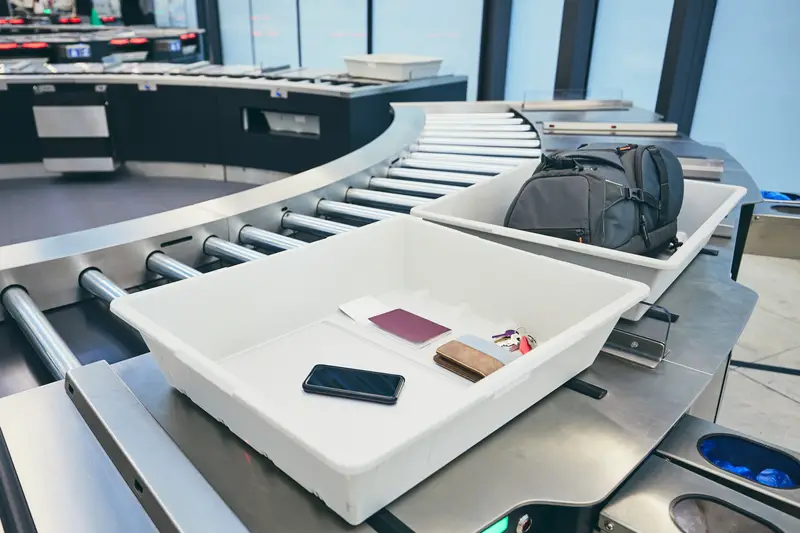Next time you’re rushing through airport security, placing your phone, wallet, keys, and shoes in those gray plastic bins, you might want to think twice before touching your face afterward. Studies have found that those security trays are crawling with more germs than a toilet seat! Yep, you read that right. Those bins that thousands of travelers touch every single day are among the dirtiest surfaces in the entire airport. And most of us have no clue we’re handling such germ magnets right before boarding a plane.
Security trays have more germs than toilet seats
It sounds hard to believe, but research from the University of Nottingham and the Finnish National Institute for Health and Welfare confirms it. When they tested various surfaces at Helsinki Airport, half of the security trays contained viruses that cause colds and flu. The shocking part? When they tested toilet surfaces in the same airport, they found zero respiratory viruses. Not a single one! The plastic material of security trays allows viruses to stick around longer than on other surfaces, and with thousands of hands touching them daily, they become perfect germ hotspots.
Another eye-opening fact is that these trays are rarely cleaned between uses. Think about it – how often have you seen anyone wiping down those bins during busy security lines? Almost never. Unlike bathrooms, which get regular cleaning throughout the day, security trays keep collecting germs from one passenger after another. A study published in the BMC Infectious Diseases journal found that rhinovirus (which causes the common cold) and influenza A were among the viruses detected on these trays. Your seemingly clean phone or wallet might be picking up these germs when they sit in the bins.
Why security trays are perfect germ spreaders
Security trays are particularly good at spreading germs for several reasons. First, they’re made of non-porous plastic, which gives viruses a perfect surface to hang out on. Unlike porous materials that might absorb and kill some germs, plastic allows viruses to survive longer. Second, these trays experience extremely high traffic – at busy airports, thousands of people use the same trays every single day. Each person puts their personal items in the tray, touching both the inside and outside surfaces, creating a constant chain of germ transfer between strangers from all around the world.
The security checkpoint area itself contributes to the problem too. It’s often crowded with people standing close together in lines, sometimes for extended periods. The poor ventilation in these areas allows airborne germs to hang around longer than in more open spaces. Plus, the stress of security checks – taking off shoes, removing laptops, emptying pockets – means most people aren’t thinking about hygiene at that moment. Many of us grab our stuff quickly after screening and then immediately touch our faces, phones, or food without washing hands, spreading those picked-up germs directly to places where they can make us sick.
The most common germs lurking on security trays
Researchers have identified several specific viruses hanging out on those security bins. The most common is rhinovirus, which is the main cause of the common cold. So if you’ve ever come down with a cold a few days after flying, those security trays might be the culprit! Influenza A, the virus responsible for most cases of the flu, was also detected on the bins. In some studies, researchers even found human coronavirus OC43, which can cause respiratory infections. These findings aren’t just interesting science facts – they show real health risks that travelers face when passing through security checkpoints.
What’s especially worrying is that these viruses can survive on hard surfaces for surprisingly long periods. Depending on the virus and conditions, they can remain active anywhere from a few hours to several days. And with the high volume of people using security trays, new germs are constantly being added to the mix. The researchers found these viruses on 10% of all airport surfaces they tested, but security trays had by far the highest concentration. This makes them a significant transmission route for respiratory illnesses in airports, potentially contributing to the spread of seasonal cold and flu outbreaks among travelers.
Airports starting to address the tray problem
The good news is that some airports are finally taking action on this gross problem. Several major U.S. airports have started introducing new antimicrobial security trays to help fight the germ issue. These special trays are made with materials that actively work to kill bacteria on contact. A company called SecurityPoint Media partnered with Microban International to create these cleaner trays, which have been rolled out to more than 30 U.S. airports already. The technology in these bins continuously fights bacteria growth 24 hours a day, 7 days a week, and doesn’t wear off over time.
Philadelphia International Airport was among the first to adopt these antibacterial trays, installing them at all security checkpoints. The trays feature an antimicrobial treatment that destroys bacteria protein upon contact with the surface. Besides the germ-fighting properties, these new trays also have other improvements like larger surface areas and special tags that make them easier to track through the X-ray system. While this technology doesn’t eliminate 100% of the germs, it’s definitely a step in the right direction for making the security process less gross for travelers.
Now that you know the truth about those seemingly innocent security trays, you can take steps to protect yourself when traveling. Pack hand sanitizer, avoid touching your face after security, and clean your personal items before using them again. While we can’t avoid security screening, we can certainly be smarter about how we handle these germ hotspots. Safe and healthy travels!

